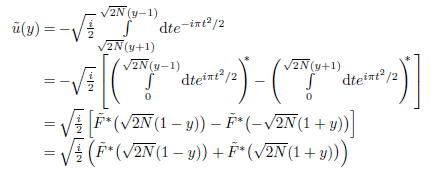|
Theoretical Physics
Multislit
Gauss Beam
|
Theory |
|
| |
| Fresnel Propagation | Fresnel-Propagation |
 with lateral coordinate
with lateral coordinate  at fixed longitudinal coordinate
at fixed longitudinal coordinate  . We want to propagate the field to the coordinates
. We want to propagate the field to the coordinates  , namely to the reduced field
, namely to the reduced field  . We do this by Fresnel approximation of Huygen's integral:
. We do this by Fresnel approximation of Huygen's integral: 
which is the convolution of
 with the fresnel propagator
with the fresnel propagator 
for the propagation length L.
 mit lateraler Koordinate
mit lateraler Koordinate  an fester longitudinaler Koordinate
an fester longitudinaler Koordinate  . Wir möchten das Feld zu den Koordinaten
. Wir möchten das Feld zu den Koordinaten  propagieren, nämlich zum reduzierten Feld
propagieren, nämlich zum reduzierten Feld  . Wir setzen dies durch die Fresnel-Approximation des Huygensschen Integral um:
. Wir setzen dies durch die Fresnel-Approximation des Huygensschen Integral um: 
welches die Faltung von
 mit dem Fresnel-Propagator
mit dem Fresnel-Propagator 
für die Propagationsdistanz L darstellt.

N is the Fresnel number of the slit, and y is the reduced transversal coordinate x taking unity at the edges of the slit. Then the Fresnel integral becomes

This integral is to be solved.

N ist die Fresnel-Zahl des Spaltes, und y ist die reduzierte transversale x-Koordinate. y ist an den Kanten des Spaltes eins. Dann wird das Fresnel-Integral:

Dieses Integral soll gelöst werden.

with


For the Fresnel integral holds

There exist analytical approximations for the Fresnel integral

where the second one holds according to Siegman also for values of x only slighter greater than unity. But for the transition region between the two regimes, no analytical approximation exists.
But Abramowitz and Stegun give a purely empirical rational approximation to the Fresnel integral, using

with


The error of this approximation is
 , but Siegman does not tell whether absulute or relative.
, but Siegman does not tell whether absulute or relative. Minor caveats against the validity of this approximation arise when looking at the examples, but the overall perfomance of the formula seems to be very precise and very good.

mit


Für das Fresnel-Integral gilt

Es existieren analytische Annäherungen des Fresnel-Integrals

wobei die zweite laut Siegman bereits für Werte von x nur leicht größer als Eins bereits gut zutrifft. Aber für den Übergangsbereich zwischen den beiden Regimen existiert keine analytische Approximation.
Jedoch geben Abramiwitz und Stegun eine rein empirische rationale Näherung des Fresnel-Integrals unter Benutzung von

mit


an. Der Fehler dieser Approximation ist
 , wenn auch Siegman nicht mitteilt, ob absolut oder relativ.
, wenn auch Siegman nicht mitteilt, ob absolut oder relativ. Untergeordnete Einwände gegen die Gültigkeit der Approximation tauchen bei Betrachtung der Beispiele auf, aber die Gesamtleistung der Formel schein sehr präzise und sehr gut zu sein.

Setting

equivalent to

the transformation is

and for the integral holds thus

The single slit integral is now expressed in terms of the Fresnel integral, for which the rational approximation by Abramowitz and Stegun is applicable.

Setzen wir

äquivalent zu

so ist die Transformation

und für das Integral gilt damit

Das Integral des einfachen Spalts ist nun in Termen des Fresnel-Integrals ausgedrückt, für welches die rationale Approximation von Abramowitz und Stegun anwendbar ist.
Anthony E. Siegman: Lasers
Sausalito, California: University Science Books, 1986
Pages 716--726
Anthony E. Siegman: Lasers
Sausalito, California: University Science Book, 1986
S. 716--726
The computation for a single slit delivers to us a full fledged field, with amplitude (in the meaning of absolute value) and phase. As the field theory underneath is linear, coherent radiation components from different sources add up linearly. Thus, computing multiple slits is nothing more complicated than summing over evaluations of the formula for a single slit at different y positions.
Die Berechnung für den einfachen Spalt liefert uns ein voll ausgebildetes Feld, mit Amplitude (im Sinne von Absolutwert) und Phase. Da die Feldtheorie darunter linear ist, addieren sich kohärente Komponenten von verschiedenen Quellen linear auf. Damit ist die Berechnung mehrfacher Spalte nichts Schwierigeres als die Summation über Auswertungen der Formel für den einfachen Spalt an verschiedenen y-Positionen.
Thus the computation of the diffraction signal of two crossed one-dimensional apertures is nothing more than the complex product of their single diffraction fields.
Somit ist die Berechnung des Beugungssignales zweier gekreuzter eindimensionaler Aperturen nicht mehr als die Bildung des komplexen Produkts ihrer einfachen Beugungsfelder.
Maintained since: 7/09
$Last changed: 7/09$